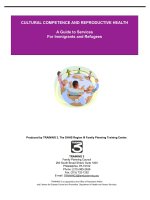INSTITUTE FOR INNOVATION AND IMPROVEMENT A GUIDE TO CREATING AND INTERPRETING RUN AND CONTROL CHARTS
Bạn đang xem bản rút gọn của tài liệu. Xem và tải ngay bản đầy đủ của tài liệu tại đây (2.62 MB, 32 trang )
<span class="text_page_counter">Trang 1</span><div class="page_container" data-page="1">
<i><b>Institute for Innovationand Improvement</b></i>
A guide to creating and interpreting run and control charts
Turning Data into Information for Improvement
</div><span class="text_page_counter">Trang 2</span><div class="page_container" data-page="2">Using this guide
The NHS Institute has developed this guide as a reminder to commissioners how to create and
analyse time-series data as part of their improvement work.
It should help you ask the right questions and to better assess whether a change
has led to an improvement.
</div><span class="text_page_counter">Trang 4</span><div class="page_container" data-page="4"><b>Improving immunisation rates</b>
Before and after the implementation of a new recall system This example shows yearly figures for immunisation rates
before and after a new system was introduced. The aggregated data seems to indicate the change was a success.
<i><b>Conclusion - The change was a success!</b></i>
</div><span class="text_page_counter">Trang 5</span><div class="page_container" data-page="5"><b>Improving immunisation rates</b>
Before and after the implementation of a new recall system <i><b>the new system?</b></i>
However, viewing how the rates have changed within the two periods tells a very different story. Here we see that immunisation rates were actually
improving until the new system was introduced. They then became worse. Seeing this more detailed time based picture prompts a different response.
</div><span class="text_page_counter">Trang 6</span><div class="page_container" data-page="6"><b>Elements of a run chart</b>
A run chart shows a measurement on the y-axis plotted over time (on the x-axis). A centre line (CL) is drawn at the median. The median is simply the 50th percentile measurement (ie, the middle data point when all the measurements are arranged in value order). The median is often written as X.
<i><small>The centre line (CL) on a Run Chart is the Median</small></i>
Run Charts
</div><span class="text_page_counter">Trang 7</span><div class="page_container" data-page="7">Two methods exist for counting the number of runs:
• Draw a circle around each run and count the number of circles you have drawn • Count the number
of times the sequence of data points crosses the median and add “1”
<b>What is a run?</b>
A run is defined as one or more consecutive data points on the same side of the median. We do not include data points that fall on the median.
How many runs are on this chart?
<i><b>14 runs</b></i>
<i><b>Points on the Median<small>(These points should be ignored when identifying runs)</small></b></i>
</div><span class="text_page_counter">Trang 8</span><div class="page_container" data-page="8"><b>Types of variation</b>
Two types of variation may be present in data that is plotted over
<b>time. These are common cause and special cause variation.</b>
<b>special cause variation </b>
then the appropriate improvement strategy is to investigate the origin of these special causes. Changing the underlying process on the basis of special causes is a waste of resources.
<b>Common cause variation</b>
• is inherent in the design of the process • is due to regular, natural or ordinary causes • affects all the outcomes of a process
• results in a “stable” process that is predictable • also known as random or unassignable variation
<b>Special cause variation</b>
• is due to irregular or unnatural causes that are not inherent in the design of the process
• affect some, but not necessarily all aspects of the process
• results in an “unstable” process that is not predictable • also known as non-random or assignable variation
</div><span class="text_page_counter">Trang 9</span><div class="page_container" data-page="9"><b>Rules to identify special cause patterns on a run chart</b>
These non-random patterns indicate special cause variation on a run chart.
<b>Rule 1</b>
• A shift in the process or too many data points in a run (6 or more consecutive points above or below the median)
<b>Rule 2</b>
• A trend (5 or more consecutive points all increasing or decreasing)
<b>Rule 3</b>
• Too many or too few runs (A table is used in conjunction with this rule and is shown on page 11)
<b>Rule 4</b>
• An “astronomical” data point (Note that this is based upon judgment rather than specific rules)
</div><span class="text_page_counter">Trang 10</span><div class="page_container" data-page="10"><i><small>Data line crosses onceToo few runs: total 2 runs</small></i>
<i><b><small>An astronomical data point</small></b></i>
<small>Source: The Data Guide by L. Provost and S. Murray, Austin, Texas. February 2007: p3-10</small>
</div><span class="text_page_counter">Trang 11</span><div class="page_container" data-page="11"><b>Using Rule 3 </b>
<b>(too few or too many runs)</b>
Use this table to identify the lower and upper limit for the number of runs. First, calculate the number of useful observations in your data set. This is done by subtracting the number of data points on the median from the total number of data points.
Then, read across to establish the lower and upper limits.
If the number of runs in your data falls below the lower limit or above the upper limit then this is a signal of a special cause.
On the earlier example of a run chart on page 7 we had 29 data points with 2 lying on the median. This gives us 27 useful observations. Using this table for 27 useful observations we expect between 9 and 19 runs. We in fact found 14 so we do not have a special
<i><small>Medical Group Practice. D Balestracci and J L Barlow</small></i>
</div><span class="text_page_counter">Trang 12</span><div class="page_container" data-page="12"><b>Elements of a control chart</b>
<b>A control chart is similar to a run chart in so far as it plots a </b>
measurement over time. However, control charts are based upon a more in-depth statistical analysis of the data and thus have some different features from a run chart.
• <b>The central line on a control chart is the mean of the </b>
measurements (instead of the median which is used in a run chart). The mean is calculated by adding up all the
measurement points and then dividing by the total number of measurement points.
• <b>A control chart has upper and lower control limits shown </b>
as horizontal lines across the chart. These lines are used when identifying special causes. In some types of control chart these lines can have a stepped appearance (as shown later for a p-chart).
• <b>Control charts have their own set of rules for identifying </b>
special causes which are generally different from the rules applied to run charts.
Control Charts
</div><span class="text_page_counter">Trang 13</span><div class="page_container" data-page="13"><b>Elements of a control chart</b>
A variety of methods exist to create control charts. The type of chart is
<b>determined by the type of data being analysed – variable or attribute.</b>
</div><span class="text_page_counter">Trang 14</span><div class="page_container" data-page="14"><b>Attribute and variable data</b>
<b>Variable data: </b>
<b>Is also known as “measurement” data. </b>
It can be measured along a continuous scale (like the scale of a ruler).
<b>Attribute data: </b>
<b>Is also known as “discrete” or “count” </b>
data. This type of data relates to attributes that can be classified into categories. For example, a patient is alive or dead, pregnant or not pregnant.
<b>Attribute data can be further classified into defectives or defects. The difference between these two is subtle but important. For defectives it is possible to count up </b>
when a defective event occurred (such as a death) as well as count up the total number of opportunities for the event to occur (such as the total number of patients who had a
<b>particular risky procedure). Thus for defectives you can calculate a percentage (such as the percentage of deaths). For defects on the other hand it is possible to know when a </b>
defect event occurred (such as a fall) but you do not know the number of non-defects
<b>(such as the number of non-falls). Instead for defects you tend to know the opportunity for a non-defect (such as the total number of patient days in hospital). Thus for defects </b>
you tend to calculate a rate (such as falls per patient day).
</div><span class="text_page_counter">Trang 15</span><div class="page_container" data-page="15">• % patients achieving above a specified outcome score
• Needle-stick injuries per week • Falls per admitted patient day
• Number of medication errors per week • Complaints per patient (which is different
from the defective measure since a patient may complain more than once)
<b>Examples of variable data: </b>
• Waiting times
• Blood pressure readings • The number of procedures
performed in a day
</div><span class="text_page_counter">Trang 16</span><div class="page_container" data-page="16">Use this decision tree to decide which type of control chart to produce.
In many health applications you will most frequently use XmR charts (for variable data) and p-charts or u-charts
(for attribute data) .
</div><span class="text_page_counter">Trang 17</span><div class="page_container" data-page="17">* A ‘subgroup’ is defined as a sample of data pulled from the stream of data produced by a process. For example, in a
laboratory setting a subgroup could be the hour of the day where we measure a sample of 50 report turnaround times within each hour. In this case the sample size (50) is our number of ‘observations’. Alternatively, if we
measured the weight loss of each patient on a particular drug regime then our subgroup is now ‘each patient’ and we have one observation
</div><span class="text_page_counter">Trang 18</span><div class="page_container" data-page="18"><b>Types of control chart (the seven basic types) with examples</b>
<b>X & R chart </b>
average & range chart
<b>Charts for variable data</b>
<b>Samples of observations (<10): Lab turnaround time </b>
(based on a small sample of requests), blood pressure (based on three readings per day)
<b>X & S chart </b>
average & standard deviation chart
<b>Samples of observations (>=10): Lab turnaround time </b>
(based on a large number of requests), patient satisfaction scores (from a sample of 50 patients per week)
<b>XmR chart (also known as an I chart)</b>
individuals & moving range chart
<b>Single observations: Waiting times, the number of calls </b>
each day, average length of stay for an HRG, weight of waste produced each day
</div><span class="text_page_counter">Trang 19</span><div class="page_container" data-page="19"><b>Defective percentage (or proportion): </b>
% caesarean sections, % mortality, % late surgery starts
<b>np-chart </b>
number of defectives
<b>Defective number (from a constant sized sample): </b>
number of caesarean sections, number of deaths, number of late surgery starts
<b>c-chart </b>
number of defectives
<b>Counts (within an equal area of opportunity): Number </b>
of falls (over a defined period), number of infections (over a defined period). Note that the “defined period” is fixed (eg, falls are counted each week and plotted weekly)
<b>u-chart </b>
defect rate
<b>Rates (within an unequal area of opportunity): </b>
Number of falls per 1000 bed days, number of ventilator associated pneumonias (VAPs) per 100 ventilator days. Note that the area of opportunity may vary (eg, each month the number of ventilator days will vary)
</div><span class="text_page_counter">Trang 20</span><div class="page_container" data-page="20"><i><small>This chart also includes a special cause (see the rules for special causes on page 23)</small></i>
</div><span class="text_page_counter">Trang 21</span><div class="page_container" data-page="21">This chart plots the moving range over time (ie, the absolute difference between consecutive measures). Upper and lower control limits are also calculated for the moving range.
</div><span class="text_page_counter">Trang 22</span><div class="page_container" data-page="22"><b>An example of a p-chart</b>
In a p-chart the control limits have this characteristic stepped appearance. This is because a control limit is calculated for each individual measure (and depends on the denominator in the percentage)
<i><small>This chart includes a special cause (see the rules for special causes on page 23)</small></i>
</div><span class="text_page_counter">Trang 23</span><div class="page_container" data-page="23"><b>Rules to identify special cause patterns on a control chart</b>
There are many rules to detect a special cause on a control chart. The following five rules are recommended for general use and will suit most applications of control charts in healthcare. The rules introduce the concept of “Sigma”. This is a value calculated when producing control limits (and is routinely calculated in all software that produces control charts). The calculation of sigma depends on the chart type but it is based upon the variability in the data. The upper and lower control limits are set at +/- three sigma.
• 8 successive consecutive points above (or below) the centre line
<b>Rule 5</b>
• 15 consecutive points within +/- 1 sigma on either side of the centre line
<b>Rule 3</b>
• 6 or more consecutive points steadily increasing or decreasing
</div><span class="text_page_counter">Trang 24</span><div class="page_container" data-page="24"><b>1 A single point outside the control limits</b>
<b>Note: A point exactly on a control limit is not </b>
considered outside the limit. When there is not a lower or upper control limit Rule 1 does not apply to the side missing the limit.
<b>2 A run of 8 or more points in a row above (or below) the centre line</b>
<b>Note: A point exactly on the centre line does not cancel or </b>
count towards a shift.
<b>3 Six consecutive points increasing (trend up) or decreasing (trend down)</b>
<b>Note: Ties between two consecutive points (ie, equal </b>
values) do not cancel or add to a trend. When control charts have varying limits due to varying numbers of measurments within subgroups, then Rule 3 should not be applied.
</div><span class="text_page_counter">Trang 25</span><div class="page_container" data-page="25"><b>4 Two out of three consecutive points near a control limit (in the outer one-third)</b>
When there is not a lower or upper control limit Rule 4 does not apply to the side missing a limit.
<b>5 Fifteen consecutive points close to the centre line (in the inner one-third)</b>
<b>Hugging the centre line.</b>
</div><span class="text_page_counter">Trang 26</span><div class="page_container" data-page="26"><i><small>In a p-chart the control limits have this characteristic stepped appearance.This is because a control limit is calculated for each individual measure (and depends on the denominator in the percentage)</small></i>
<i><small>Frozen Control LimitsCentre line</small></i>
<b>Testing a process change (freezing the control limits)</b>
To test whether a process change has improved a stable process, firstly freeze the control limits and the centre line at the pre-change levels. Then extend these into the post-pre-change period.
Process Changes
<i><b>where will the process go?</b></i>
</div><span class="text_page_counter">Trang 27</span><div class="page_container" data-page="27"><b>Testing a process change (looking for a special cause)</b>
Next plot the post-change data. Using the old control limits and centre line look for a special cause. If you detect a special cause it is a sign that the process has measurably changed.
<i><small>A special cause is detected.A run of 8 or more data points onone side of the centre line reflectinga shift in the process (Rule 2)</small></i>
</div><span class="text_page_counter">Trang 28</span><div class="page_container" data-page="28"><i><small>New control limits and centre line based upon thenew (changed) process</small></i>
<b>Testing a process change (understanding the new process)</b>
If a special cause is detected, calculate a new centre line and control limits for the post-change data. These are calculated in exactly the same way as usual but only using the post-change data.
</div><span class="text_page_counter">Trang 29</span><div class="page_container" data-page="29">Recommended Reading
This short guide has been produced by the NHS Institute for Innovation and Improvement to support teams using run and control charts in service improvement projects.
The content of this guide is based upon the work of Dr Robert Lloyd (Executive Director Performance Improvement, Institute for Healthcare Improvement). We are indebted to Dr Lloyd for his support in helping us to promote the science of improvement in the NHS. To learn more about the science of improvement and the use of run and control charts, we recommend:
<i><b>•RCLloyd,Quality Healthcare: A guide to developing and using indicators, Jones </b></i>
<b>and Bartlett (2004)</b>
<i><b>•JCBenneyan,RCLloyd,PEPlsek,Statistical process control as a tool for research </b></i>
<i><b>and healthcare improvement, Quality and Safety in Health Care 2003;12:458–464</b></i>
<i><b>•MAMohammed,PWorthington,WHWoodall,Plotting basic control charts: </b></i>
<i><b>tutorial notes for healthcare practitioners, Quality and Safety in Health Care </b></i>
<i><b>•DBalestracci,JLBarlow,Quality Improvement: Practical Applications for Medical </b></i>
<i><b>Group Practice,MedicalGroupManagementAssociation(1996)</b></i>
</div><span class="text_page_counter">Trang 30</span><div class="page_container" data-page="30">Notes
</div><span class="text_page_counter">Trang 31</span><div class="page_container" data-page="31"><small>31</small>
</div><span class="text_page_counter">Trang 32</span><div class="page_container" data-page="32">Further copies of this guide can be ordered from our online catalogue.
Product code: NHSICommruncont1
NHS Institute for Innovation and Improvement
<small>© NHS Institute for Innovation and Improvement 2009. All Rights Reserved</small>
</div>








